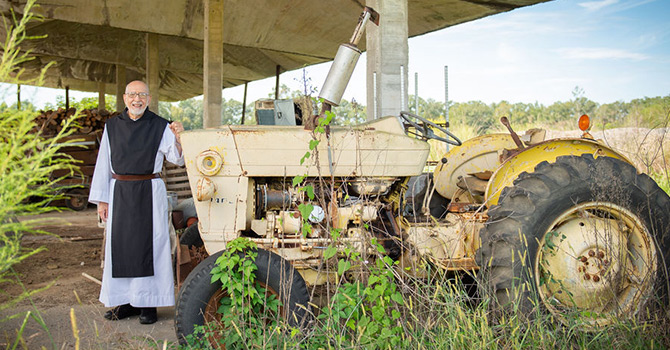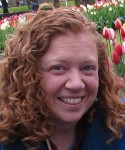It’s dark and still when the bell tower chimes at 3 a.m., calling the monks of Mepkin Abbey to prayer. Monks, like farmers, are early risers.
A breeze stirs atop this bluff along the Cooper River, 40 miles outside Charleston, South Carolina. Like a morning yawn, the air rustles the branches of grand live oaks, their old, bowed limbs cloaked in vestments of Spanish moss.
The Chickasaw and Cusabo Indians hunted and fished here, and enslaved people grew rice, indigo, corn and peas on what was once a 7,000-acre plantation. Later in its history, the land was bought by publishing magnate Henry Luce and his ambassador and writer wife, Clare Boothe Luce, as a winter retreat. They are buried here, having donated the 3,000-acre abbey plot to the Trappists in 1949.
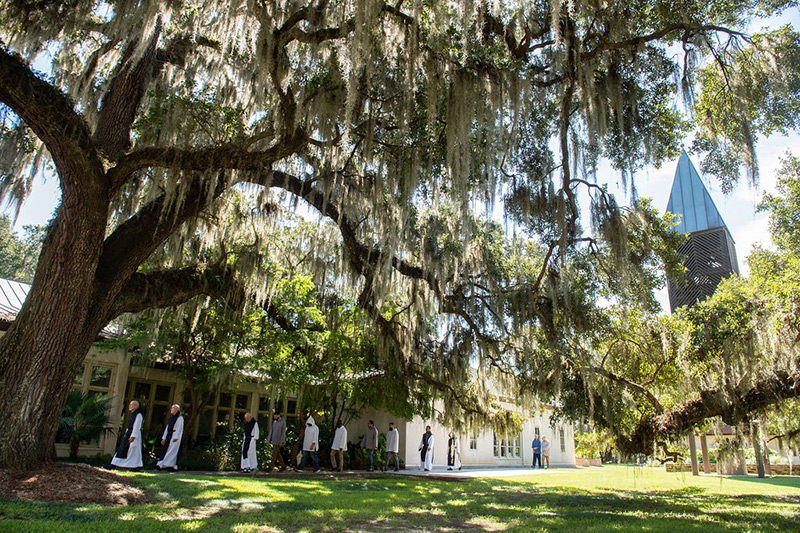
Since then, the monastery’s pre-dawn bells have marked the beginning of a centuries-old daily discipline of following the liturgy of the hours. The monks observe silence, pray the Psalms and tend the land in a life of simplicity and reverence.
Mepkin is holy ground with deep agricultural roots and a life formed by ancient monastic tradition -- parallel systems from which the monks today are cultivating a new growth opportunity for unvowed participants, the Institute for Regenerative Agriculture.
What story, image, tradition or history grounds your organization, and how have you continued to return to it throughout your institution’s life? How might a study of your history help you innovate for the future?
Launched this summer, the institute is structured as a 10-month residential internship that offers comprehensive, hands-on education for becoming a successful small farmer set within an immersive experience of monastic life.
The goal is twofold: to train and support new farmers in creating more viable local food systems, thereby reconnecting people to fresh food and health, and to connect participants to the fruit of the contemplative life.
“We use the tag line ‘Grow food and find your center,’ because the two are intertwined,” said the Rev. Joe Tedesco, the abbey’s superior.
“It’s what happens when you get your hands in the dirt. Working with the earth and healing the environment grounds and rejuvenates you, and the spirituality piece gives a deeper reality to that focus,” he said.
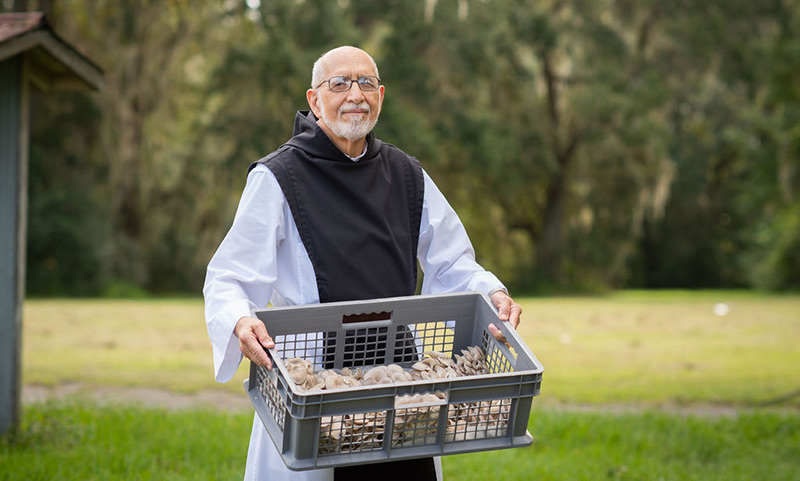
Mushrooms and more
Tedesco and his fellow Mepkin monks, of the Order of Cistercians of the Strict Observance -- and indeed, Trappist monks across the globe -- have long been steeped in agriculture. The Rule of St. Benedict, which governs the Cistercian order, dictates that monks participate in manual labor up to five hours a day to support their communal lifestyle. The type of labor, and the products that result, varies from monastery to monastery, but it typically involves farm work. Trappists are renowned for their beer, preserves, cheeses and produce.
“For 1,500 years, monks have been lovers of the land and cultivators of the earth. We want to stay in that business and continue our tradition,” Tedesco said.
Mepkin’s monks have worked this land for timber and vegetables and for many years operated a successful egg farm before transitioning to mushroom growing in 2009. Their oyster mushrooms, prized by Charleston’s chefs, are cultivated in high-tech, climate-controlled growing rooms, some of which previously housed the abbey’s chickens.
Mushrooms are now the main source of Mepkin’s revenue, sold through wholesale produce suppliers to restaurants and local grocery stores and at the abbey gift shop.
But farm work is hard, and Mepkin’s workforce is smaller and older than it used to be. In the 1950s through the 1970s, there were close to 50 monks living at Mepkin; today, there are 15, with an average age of 77.
This decline reflects a broader and “worrying” trend, according to the most recent report from the Vatican Central Office for Church Statistics. The number of religious brothers worldwide experienced an 8% drop between 2013 and 2018.
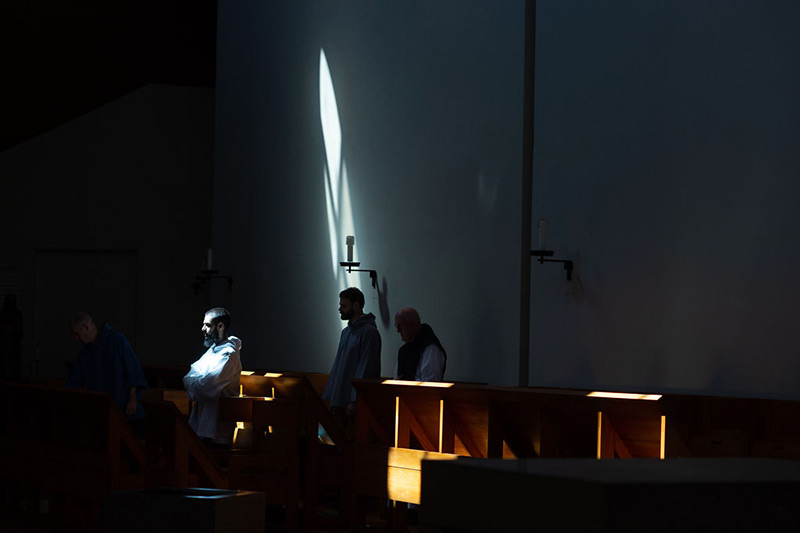
“To maintain and expand our operation, we need more help,” said Tedesco, who five years ago reached out to Jimmy Livingston, a successful small farmer 6 miles up the road at Wabi Sabi Farm, to assist the monks and manage the mushroom production.
Meanwhile, at an interreligious gathering that Mepkin hosted in 2017, Tedesco became aware of a dearth of affordable land for new farmers.
“Our group of Buddhist, Sufi and Trappist monks, a Franciscan sister, a Jewish community organizer and a Protestant minister spent a weekend together sharing stories. It was powerful,” Tedesco said. “If you let go of the exterior stuff and get down to the experience of the divine, it’s all the same. We found connection.”
What kinds of resources can your organization access (financial, material, human, etc.)? Take time to think about these resources in new ways.
The Jewish leader spoke about meeting many young people -- fellow spiritual seekers -- who want to be farmers but lack resources to acquire or access land.
“I realized we have the land and we want to invite seekers,” Tedesco said. “The idea of the institute just came to me.”
While the abbey church, refectory, and monks’ housing quarters, the Clare Boothe Luce Library of theological resources, and the relatively new conference and retreat center form the hub of the monastery, there are more than 100 acres of farmable fields on the surrounding Mepkin property. Tedesco realized that the abbey was well poised to connect people both to the land and to contemplative practice.
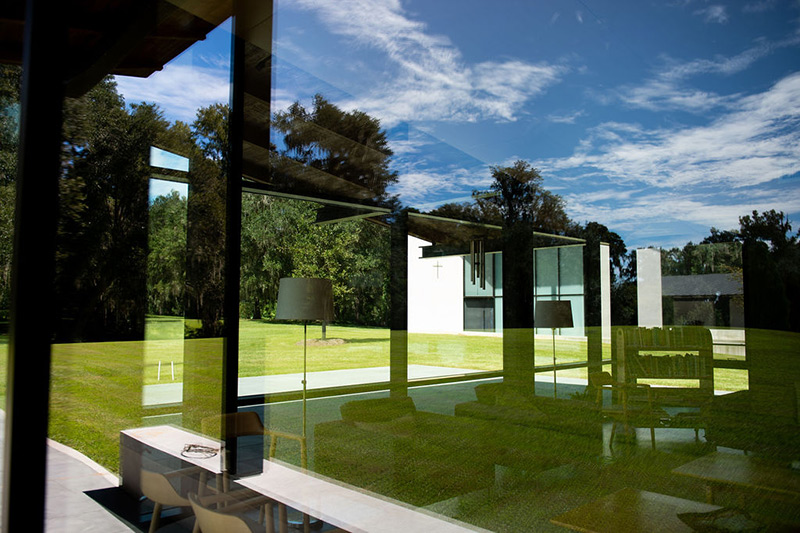
Interspiritual experiences
The Institute for Regenerative Agriculture is a new arm of the already-established Mepkin Affiliate program, which offers three other avenues for the unvowed to experience monastic life. Monastic “guests” come for a monthlong immersion in the community; monastic “residents” commit to a yearlong intensive experience; and the annual Mepkin Monastic Institute brings in 16 participants for a month of seminars on the Rule of Benedict and the core elements of Cistercian life.
The affiliate program grew out of the monks’ belief that the wisdom of an ancient monastic tradition has much to offer 21st-century spiritual seekers, said the Rev. Guerric Heckel, who oversees the program and Mepkin’s retreat center.
“Monasticism offers an alternative to the dominant, consumer-driven culture,” he said. “Here people find a supportive, nurturing environment that allows an entree into human wholeness and spiritual flourishing, their ‘search for the center,’ which is less accessible in the larger culture.”
The Institute for Regenerative Agriculture, like the other affiliate opportunities, offers what Heckel calls an “interspiritual experience,” which differs from ecumenical or interfaith experiences.
“There is a sharing from a more contemplative and experiential level,” he said. “So the question becomes not so much, ‘What do you believe?’ but, ‘How do you pray?’ ‘How do you experience God, the Holy, the Sacred?’”
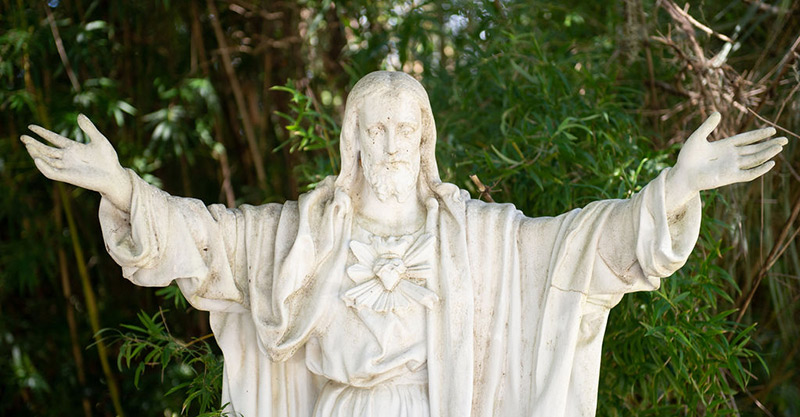
Heckel, Tedesco and Livingston began planting seeds for this new affiliate experience that would deepen both the monks’ and the farm interns’ ties with the land, grow more produce for the extended community, and potentially boost the dwindling monastic community. Each intern, in addition to learning farming skills, is paired with a monk mentor to guide the intern’s spiritual journey while at Mepkin.
The potent combination could be regenerative for the land, for the soul and perhaps even for the monastery.
“The idea of regenerative farming -- it’s solid, man. When you come out to this beautiful land and separate from outside influences, when you devote yourself to being more reflective and focus on growing things, which requires attention and dedication, it kind of heals you,” Livingston said.
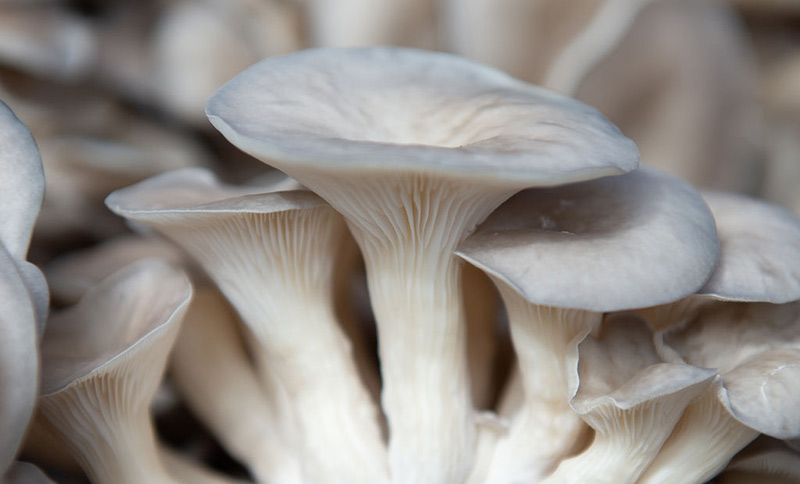
Comprehensive curriculum
Livingston reached out to Zack Snipes, Clemson University’s Cooperative Extension agent in charge of fruits and commercial vegetables, to assist in creating a curriculum to augment the hands-on lessons that Livingston could teach and share.
“Clemson is giving us the science behind organic farming,” Livingston said.
What unusual community partners might use their skills to help you envision and live into your organization’s next chapter?
Snipes was eager to help. He grew up hearing about Mepkin -- his grandfather fished on the property -- and as a child, he had been curious about the mysterious monks. Through his work with Clemson, Snipes got to know the brothers while consulting on aspects of the mushroom farm. When he needed a mentor for a leadership program, he chose one of Mepkin’s monks.
“The monastic community is one of the oldest agricultural societies. I’m over the moon to get to be a part of their history,” Snipes said.
“Mepkin’s farm has evolved over the decades, from timber to row crops, then eggs and mushrooms,” he said. “This is another chapter of that story. Jimmy is an incredible farmer, and with Clemson providing the technical assistance, there’s an unbelievable potential for growth for what they can do in the field and in people’s lives. I’m glad to be a part of it and that Clemson’s a part of it.”

Snipes and his colleagues developed a curriculum offering a range of classes, some of which are part of the general Clemson Extension program and some that he has tailored for Mepkin, including the business basics of farming.
The plan was to start with six farm institute interns -- three men and three women. Tedesco placed an ad in Mother Earth magazine and a Catholic newspaper, and placed application information on Mepkin’s website. Only one woman applied, and she and three male applicants were accepted.
COVID-19, however, presented unforeseen complications.
Pandemic restrictions created housing obstacles that made hosting women impossible this year. One of the male applicants lived on the West Coast and was unable to travel because of the pandemic. So they launched with two interns, with plans to expand.
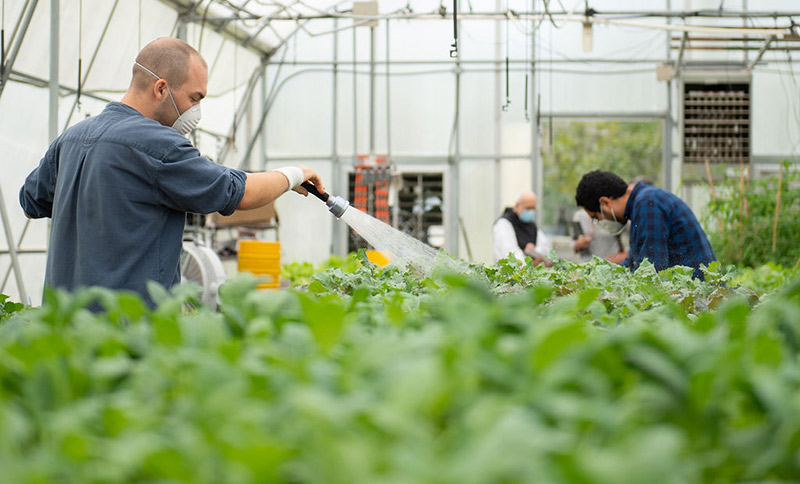
A symbiosis happening
This summer, Livingston and the interns, Walid Yaghy and Jordan Hoban, have been busy learning the mushroom operation, planting cover crop in the fields to return nitrogen to the soil, clearing fields for late fall planting and managing a greenhouse full of plants started from seed -- kale, collards, lettuces, artichokes, lemon grass, chicory.
Their classes, now via Zoom, have ranged from business practices to soil fertility, soil prep, crop transfers, strawberry growing and seasonal vegetable production.
The institute is offered at no cost to the interns, aside from an initial reservation deposit. Clemson Extension also provides its programs for free. Eventually, a Mepkin farm stand selling produce will help make the program self-sustaining, but income is not the goal.
“Our experience is living contemplatively, living from the perspective of the presence of God in creation and the world and each other. If we can help people get in touch with that and live their life out of that, that’s our goal,” Tedesco said.
What constitutes a core group from your organization, and who are those constituents or others who can help disseminate your key message?
If participants discover a calling for monastic life, “that’s all well and good,” he said. But it’s not the point.
“As long as we can maintain a core group of the vowed religious, we have what it takes to keep the monastery. Expanding with circles of people who can join us for a period of time helps keep us going, but even more, they then also reach out and change the world,” he said. “That’s how we view this whole thing. We think that’s valuable for us and for the world.”
As the greenhouse plants mature and begin to be planted in Mepkin’s freshly plowed fields, Tedesco and Livingston are also seeing the interns grow.
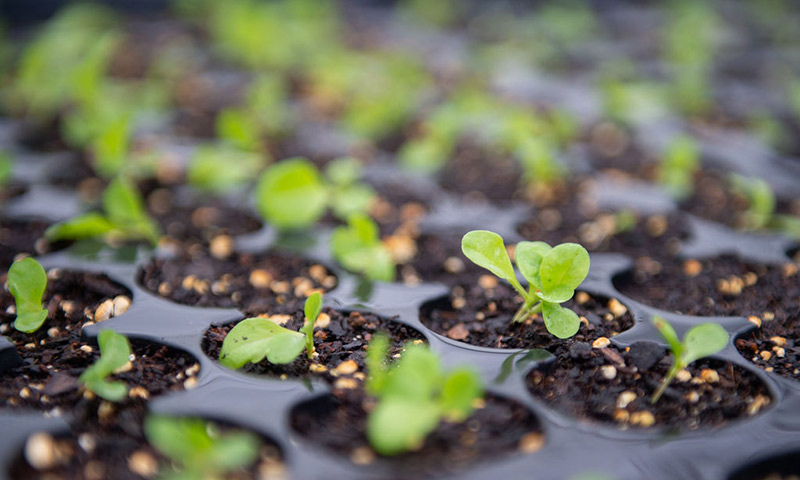
“I had only had a small garden at home,” Yaghy said, “so working on a large scale like this is new to me. I’m learning from the best.”
Hoban, a musician by trade, had previously volunteered on an organic farm.
“Here, I’m getting the holistic experience, starting from the ground, prepping the soil and planting seeds, and working on up,” he said. “I’m becoming confident in my ability to start my own garden, grow my own food and even successfully sell my product.”
The development extends beyond the plants.
“In terms of their spiritual reality, I’m seeing a symbiosis happen. As they touch the earth, they begin to touch their center,” Tedesco said.
Hoban is not Catholic but is settling into the rhythm of the monk’s life and making connections between the round bread of communion and the earth. He never misses Eucharist.
“This is the first time I have ever seen a circle wafer raised by the priest into the morning sun, broken into pieces, everyone standing in a horseshoe shape around the altar, hands outstretched as the priest places within them a small fragment of something that I had seen moments before to be perfectly whole,” he said. “The symbolism is still working in me.”
Yaghy, who was a music teacher before taking on the internship, said he was interested in the farming aspect but was particularly drawn to the opportunity to explore monastic traditions, to learn from the monks and “to create a space to listen better to my inner life.”
“The pace of life at the monastery is so much slower. There’s no TV or radio; it’s harder to distract yourself there,” he said.
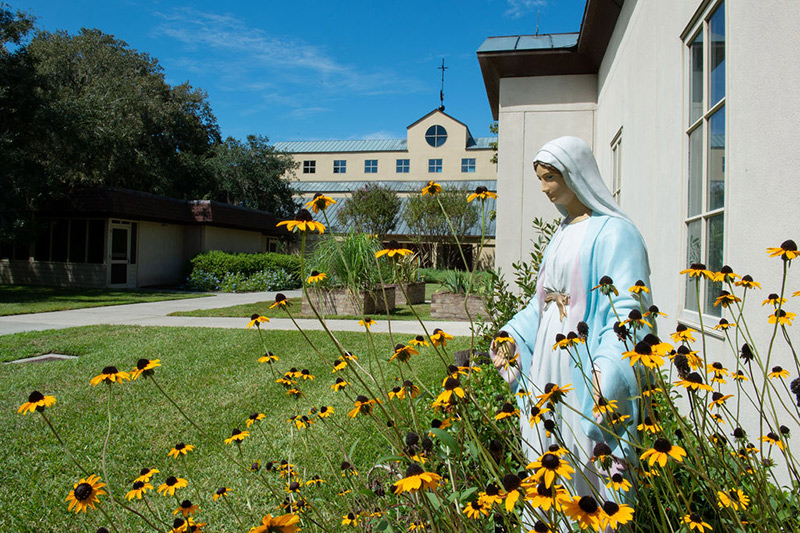
“I think the monastic life has helped me focus on acknowledging my emotional reactions, to learn to sit with them, make space in your thought process, to commune with yourself, check in with yourself. Spending time outside, doing something with your hands, working with the earth is quite therapeutic," Yaghy said. "It’s hard work, but knowing there’s a process you’re a part of that’s bringing life into the world and nurturing that is deepening my awareness of how things are interconnected.”
Despite COVID-19’s challenges, the institute’s launch has been successful thus far and is providing valuable lessons for improvement as the program evolves. For example, Tedesco has recognized the need for a more thorough orientation before the interns begin.
“The guys probably needed more information about the dynamic of monastic life so they know better what they’re getting into,” he said. “It took us a while to figure out what leeway to give them so they’re comfortable.”
The brothers have also learned “to be attentive to who is interested in us and what’s the best fit,” he added. There may be better avenues for advertising the program, and exploring funding opportunities to underwrite intern stipends could help lessen the financial burden for those who are interested but can’t afford 10 months without income.
“We’re learning and exploring as we go,” Tedesco said.
This sense of being attuned and responsive seems to be crucial in both monasticism and farming.
“We need to be prophetic in the order,” Tedesco said. “We must ask ourselves, ‘How does this 1,000-year-old Cistercian tradition renew for the future in today’s world?’ We’ve lasted a thousand years by being adaptive while remaining true to our charism. So the question is, ‘How do we adapt now?’”
Inviting seekers to join in working the soil and learning the regenerative, soulful nature of agriculture is one way Mepkin is answering this question.
“This is a business of hope,” Livingston said. “When you put a seed in the ground, you’re looking to the future.”
Questions to consider
Questions to consider
- Traditioned innovation is “a way of thinking and being that holds the past and future in tension, not in opposition” and “is crucial to the growth and vitality of Christian institutions.” What story, image, tradition or history grounds your organization, and how have you continued to return to it throughout your institution’s life? How might a study of your history help you innovate for the future?
- Mepkin Abbey is making new use of farmable land through its Institute for Regenerative Agriculture. What kinds of resources can your organization access (financial, material, human, etc.)? Take time to think about these resources in new ways.
- Tedesco reached out to a successful small farming neighbor and a Clemson University Extension agent to help the abbey envision its future. What unusual community partners might use their skills to help you envision and live into your organization’s next chapter?
- Tedesco said, “We’ve lasted a thousand years by being adaptive while remaining true to our charism.” The abbey models for Christian institutions how a shrinking organization can sustain and even grow its mission. For Tedesco, maintaining “a core group of the vowed religious” is enough. They can rely on the circles of those who come and go in their new farm programs to “reach out and change the world.” What constitutes a core group from your organization, and who are those constituents or others who can help disseminate your key message?

